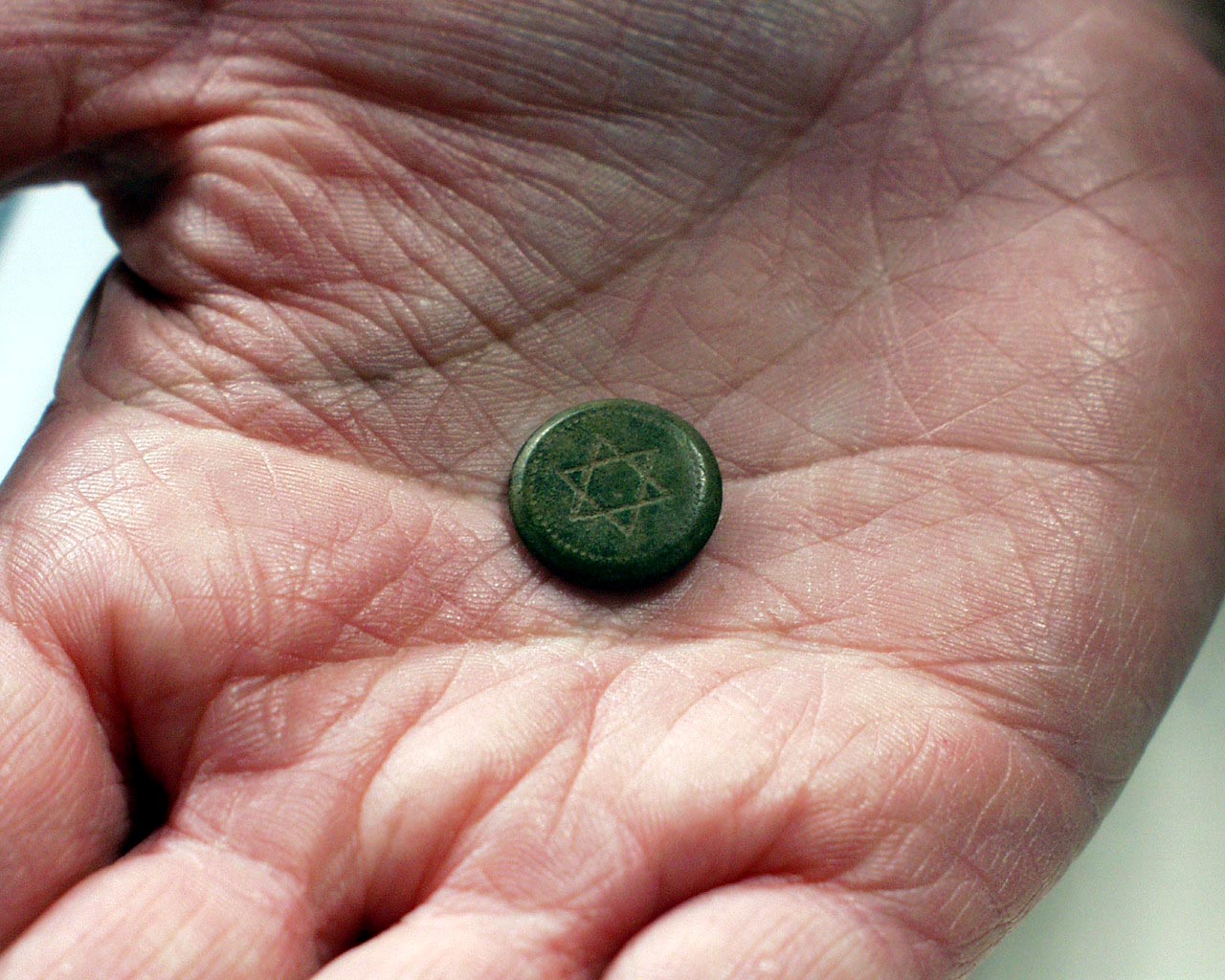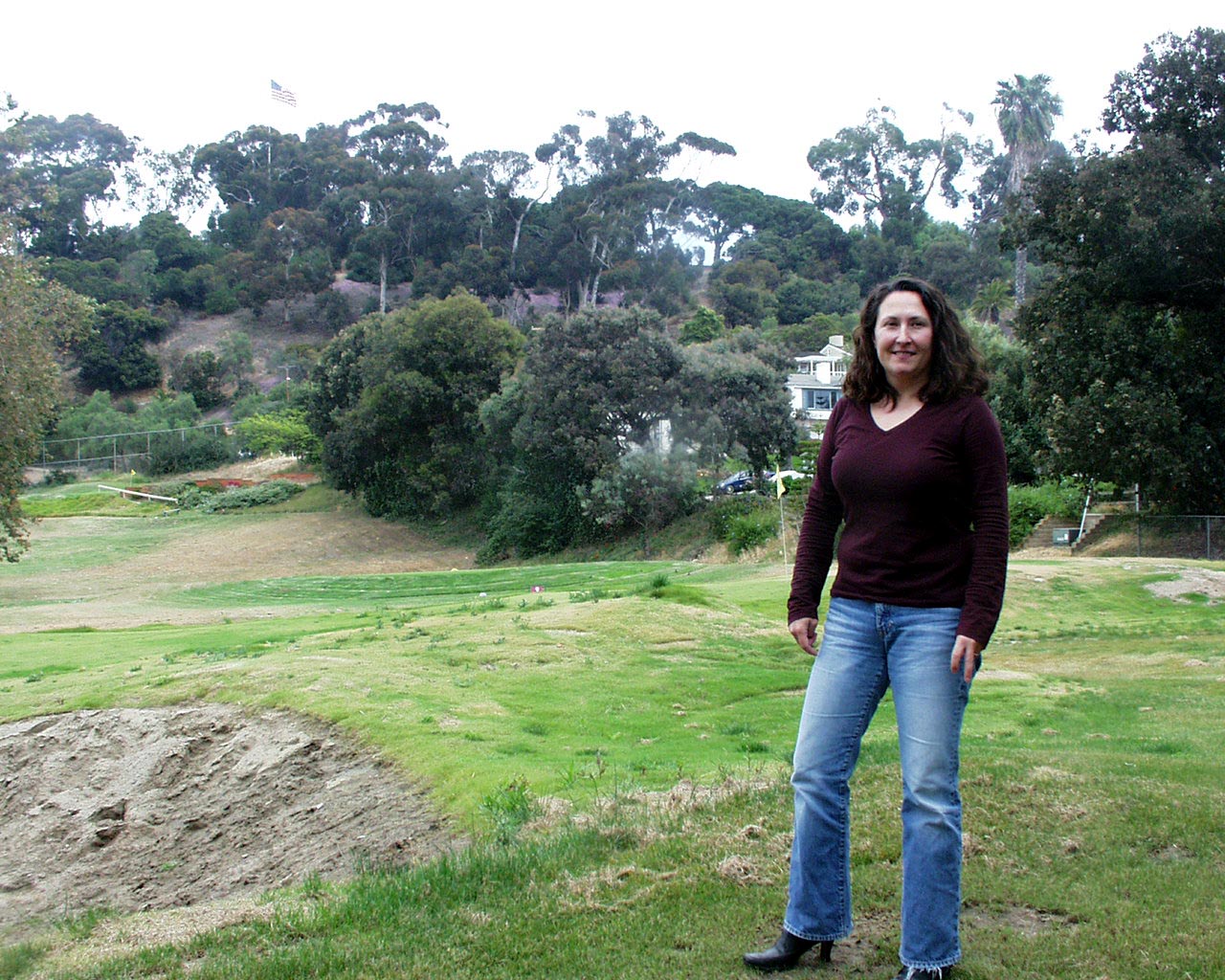|
By Donald H. Harrison
SAN DIEGO, Calif.— When operators of the Presidio Golf Course started building
a driving range last year, an old bottle on top of what appeared
to have been a filled-in well was uncovered. A passerby sensitive to the
importance of archaeology notified Myra Hermann, a senior environmental planner
with the City of San Diego's Development Services Department.
Construction was stopped and arrangements were made promptly to have an
archaeological survey done by the firm of Mooney Jones & Stokes of the site located between the old Spanish Presidio
and what today is known as Old Town San Diego State Historic Park.
 Stacey C. Jordan-Connor, Mooney Jones & Stokes director of cultural resources, said a metal button with a simple Star
of David design was among the artifacts recovered from a 35-foot long, 4-foot wide
trench that was cut down to the level of disturbance during a four-day-dig.
Stacey C. Jordan-Connor, Mooney Jones & Stokes director of cultural resources, said a metal button with a simple Star
of David design was among the artifacts recovered from a 35-foot long, 4-foot wide
trench that was cut down to the level of disturbance during a four-day-dig.
Although today part of an 18-hole pitch and putt golf course, the land that was
excavated by the archaeologists formerly featured a corral and stable owned by
Prussian-born partners Joseph S. Mannasse and
Marcus
Schiller, two19th century
Jewish entrepreneurs who also were important historical figures in San Diego.
Mannasse immigrated via San Francisco to San Diego in 1853 in the company of his
brother, Heyman, and cousin, Moses. Schiller arrived in San Francisco about the
same time that the Mannasses were leaving that city. Schiller migrated to
San Diego in 1856, becoming partners with Mannasse in a general store located
across what today is Juan Street from the subject property.
During the 1860s, Schiller became a grand master of the San Diego Masonic Lodge,
and like his partner, served on the Board of Trustees of the City of San
Diego. Mannasse, in fact, was on the Board that cleared the way for a
large tract of land to be set aside for a city park; Schiller, replacing his
partner on the board the following year, formally voted to create the park. Many
years later the large city park would become known as Balboa Park.
Schiller also was active in the affairs of San Diego's small Jewish community,
becoming the first president of Temple Beth Israel, which opened its doors for
High Holiday services in 1889.
As a matter of coincidence, the Temple Beth Israel building
where Schiller presided now is located just a few blocks up Juan Street in
Heritage Park. The building's original location was at 2nd and Beech
Street, closer to downtown San Diego, but it was relocated and restored
nearly a century later thanks to the efforts of philanthropist Jim Milch, the
Save Our Heritage Organization, and the County of San Diego, operator of the
Heritage Park.
Together Mannasse & Schiller laid out a real estate development known
as the Mannasse & Schiller Addition, located between Old Town San Diego and
Roseville, a town site created on San Diego Bay by San Diego's original Jewish
settler, Louis
Rose. Mannasse & Schiller's real estate speculations
also prompted them to purchase ranch land covering the coastal area of San Diego
County now occupied by the City of Encinitas.
There is no way of knowing whether the Star of David button found during the
2005 archaeological dig belonged to either of the partners, as there were other
Jewish merchants and family members who lived in San Diego during the 19th
century who might have visited Mannasse & Schiller's corral and stable.
Other interesting buttons also were found at the site, including some from
military uniforms. Four of these buttons bear a relief image of the
mythical Phoenix bird and an encircling model in French, je renais de me
cendres (I am reborn from my ashes.)
 In a recent interview at the golf course, Dr. Jordan-Connor said team members
recognized from published materials the Phoenix buttons
as having been made in England for the troops of self-proclaimed King Henri
Christophe of Haiti, who reigned over the former French colony from 1811-1820.
These buttons may have reached San Diego in the complex web of international
trade—and, one might speculate, so too could the little Star of David
button reached the Mannasse & Schiller corral site
serendipitously.
In a recent interview at the golf course, Dr. Jordan-Connor said team members
recognized from published materials the Phoenix buttons
as having been made in England for the troops of self-proclaimed King Henri
Christophe of Haiti, who reigned over the former French colony from 1811-1820.
These buttons may have reached San Diego in the complex web of international
trade—and, one might speculate, so too could the little Star of David
button reached the Mannasse & Schiller corral site
serendipitously.
The Presidio Golf Course is adjoined by the tiny Casa de Carrillo, which was
built in 1821 and is considered the oldest standing structure in San Diego. The
property is associated with one of San Diego's best-known love stories. Josefa
Carrillo, forbidden to marry Yankee sea captain Henry Delano Fitch by the
jealous Mexican Gov. Jose Maria Echeandia, ran one night in 1829 from her
adobe home to the nearby Pear Garden, where her friend Pio Pico—a future
Mexican governor of California—waited with two horses. Together, they
rode to San Diego Bay, where Josefa met Henry and the couple boarded a
ship and sailed off together for marriage in Chile.
The land had a succession of owners between the time it was owned by Mannasse
& Schiller and 1931, when it was purchased by George Marston, an influential
lover of history who also constructed the Serra Museum atop nearby Presidio
Hill.
Wanting to keep the land between the Presidio and Old Town in open space, he
hired William P. Bell to lay out a par-3, 18-hole golf course. Bell
already was renowned as the designer of golf courses in Balboa Park and at the
La Jolla Country Club, as well as at the Bel Air Country Club in Los Angeles and
on the Wrigley-family-owned Catalina Island. Later in his career, he would
lay out the golf course at Tilden Park in Berkeley, and design a course at
Torrey Pines, which was completed by his son, William F. Bell.
Jordan-Connor said that most of the material found in the trench can be
dated to the mid-19th century when Old Town was the center of commercial
activity in San Diego. However, there are less likely possibilities that
some artifacts may be from other periods. To build the golf course, Marston had the land scraped and
reshaped. so there is at least a chance that Marston himself or people associated with
the golf course project might have lost those interesting buttons.
Similarly, it cannot be
known definitively whether or not some of the artifacts landed at the site in
the interim period between the Mannasse
& Schiller period and the golf course construction, or even from
the period prior to Mannasse & Schiller's ownership when the land was
traversed by a path leading from the old settlement to Presidio Hill.
In addition to 23 buttons recovered during the dig, thousands of other items
were turned up by archaeologists who sifted dirt through one-quarter inch
mesh. There was an intriguing arrow point made from porcelain, perhaps an
adaptation of Native American (Kumeyaay) culture using European
materials.
Additionally there were shards of pottery, clay pipes, marbles, bottles,
jars, tumblers, stemware, nails, tacks, screws, washers, a gun flint, a writing
slate, bone knife handle, bottle fragments, bones from butchered cows, and an
interesting variety of shells—to name only some of the catalogued finds. The
City of San Diego, in cooperation with the San Diego Archaeological Center,
maintains such collections of artifacts.
|

